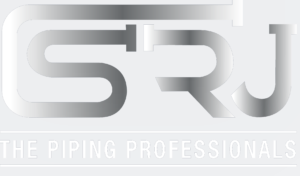Compressed Air Piping vs. Traditional Pneumatic Systems: Which One Is More Efficient?
Comparing performance, cost, and energy efficiency to help you choose the right system for your industrial needs
Industrial facilities rely heavily on pneumatic systems for automation, tool operation, and material handling. The choice between compressed air piping and traditional pneumatic systems significantly impacts energy efficiency, maintenance costs, and operational reliability. At SRJ Piping India, we've installed both systems across various industries and can help you determine the best solution for your facility.

Modern compressed air piping systems offer significant efficiency advantages
Head-to-Head Comparison
Compressed Air Piping
Engineered piping systems designed specifically for high-efficiency air distribution with minimal pressure drops.
Advantages:
- Up to 30% more energy efficient
- Lower pressure drops (1-2 psi vs. 5-10 psi)
- Reduced leakage (typically <5%)
- Modular design for easy expansion
- Longer lifespan (20+ years)
Limitations:
- Higher initial investment
- Requires professional installation
- Less flexible for frequent layout changes
Best for: Large facilities, high-demand applications, energy-conscious operations.
Traditional Pneumatic Systems
Conventional systems using standard piping materials like galvanized steel or copper with push-to-connect fittings.
Advantages:
- Lower upfront cost
- Easier to install and modify
- Wider availability of components
- Familiar technology for maintenance teams
Limitations:
- Higher energy consumption
- Greater pressure losses
- More frequent leaks (10-30% loss common)
- Shorter service life (10-15 years)
Best for: Small facilities, temporary installations, low-budget projects.
Efficiency Comparison
| Factor | Compressed Air Piping | Traditional Pneumatic |
|---|---|---|
| Energy Efficiency | 85-95% | 60-75% |
| Pressure Drop (per 100 ft) | 1-2 psi | 5-10 psi |
| Typical Air Leakage | <5% | 10-30% |
| Installation Cost | $$$ (Higher initial) | $ (Lower initial) |
| Lifespan | 20+ years | 10-15 years |
| Maintenance Frequency | Low | Moderate to High |
| ROI Period | 2-4 years | N/A |
Key Insight: While compressed air piping has higher upfront costs, the energy savings typically provide a full return on investment within 3 years in most industrial applications.
Ideal Application Scenarios
Large Manufacturing Plants
Recommended: Compressed air piping
Why: The energy savings at scale justify the initial investment, and the reduced downtime pays dividends in production continuity.
Small Workshops
Recommended: Traditional pneumatic
Why: Lower air demands make the efficiency gains less significant, while budget constraints favor simpler systems.
Automotive Assembly
Recommended: Hybrid approach
Why: Compressed air mains with traditional drops to workstations balances efficiency with flexibility.
Cost Analysis Over 10 Years
For a Typical 50,000 sq. ft. Facility:
- Compressed Air Piping:
- Installation: ₹25 lakh
- Energy Costs: ₹8 lakh/year
- Maintenance: ₹1 lakh/year
- Total 10-year Cost: ₹1.15 crore
- Traditional Pneumatic:
- Installation: ₹15 lakh
- Energy Costs: ₹12 lakh/year
- Maintenance: ₹2.5 lakh/year
- Total 10-year Cost: ₹1.6 crore
Conclusion: The compressed air system saves ₹45 lakh over 10 years despite higher initial costs.
Hybrid Approach: Best of Both Worlds
Many facilities achieve optimal results by combining both technologies:
- Compressed air piping for main distribution lines
- Traditional pneumatics for final drops to workstations
- Smart pressure regulators to optimize each zone
- Leak detection systems throughout
This approach typically delivers 80% of the energy savings of full compressed air piping at 60% of the cost. Our engineers can help design the right hybrid solution for your facility.
Need Help Choosing the Right System?
Our pneumatic system experts can assess your facility and recommend the most efficient solution for your specific needs and budget.
Frequently Asked Questions
Typically 20-30%, with these specific savings areas:
- 15-20% from reduced pressure drops
- 5-10% from minimized leaks
- 3-5% from optimized compressor operation
For a facility spending ₹10 lakh/year on compressed air energy, this means ₹2-3 lakh in annual savings.
The top options in 2024 are:
- Aluminum: Lightweight, corrosion-resistant, easy to install (most popular)
- Stainless Steel: Maximum durability for harsh environments
- Composite: Lightweight but higher cost
We recommend against PVC (brittle) or black iron (corrodes).
Yes, we typically recommend a phased approach:
- Phase 1: Replace main distribution lines
- Phase 2: Upgrade high-usage branches
- Phase 3: Convert remaining drops as budget allows
This spreads costs while delivering immediate energy savings. Our retrofit specialists can develop a custom plan.
Compressed Air Piping:
- Annual inspections
- Leak audits every 2-3 years
- Filter changes as needed
Traditional Pneumatic:
- Quarterly leak checks
- Frequent fitting replacements
- More compressor maintenance
The reduced maintenance typically saves ₹1-2 lakh annually for mid-sized facilities.
